Strain Engineering in Ni-Co-Mn-Sn Magnetic Shape Memory Alloys: Influence on the Magnetic Properties and Martensitic Transformation
Abstract
:1. Introduction
2. Calculation Method
3. Results and Discussions
4. Conclusions
Author Contributions
Funding
Institutional Review Board Statement
Informed Consent Statement
Data Availability Statement
Conflicts of Interest
References
- Krenke, T.; Duman, E.; Acet, M.; Wassermann, E.F.; Moya, X.; Mañosa, L.; Planes, A. Inverse magnetocaloric effect in ferromagnetic Ni–Mn–Sn alloys. Nat. Mater. 2005, 4, 450–454. [Google Scholar] [CrossRef] [PubMed]
- Han, Z.D.; Wang, D.H.; Zhang, C.L.; Tang, S.L.; Gu, B.X.; Du, Y.W. Large magnetic entropy changes in the Ni45.4Mn41.5In13.1 ferromagnetic shape memory alloy. Appl. Phys. Lett. 2006, 89, 182507. [Google Scholar] [CrossRef]
- Sutou, Y.; Imano, Y.; Koeda, N.; Omori, T.; Kainuma, R.; Ishida, K.; Oikawa, K. Magnetic and martensitic transformations of NiMnX (X = In, Sn, Sb) ferromagnetic shape memory alloys. Appl. Phys. Lett. 2004, 85, 4358. [Google Scholar] [CrossRef]
- Kainuma, R.; Imano, Y.; Ito, W.; Morito, H.; Sutou, Y.; Oikawa, K.; Fujita, A.; Ishida, K.; Okamoto, S.; Kitakami, O.; et al. Metamagnetic shape memory effect in a Heusler-type Ni43Co7Mn39Sn11 polycrystalline alloy. Appl. Phys. Lett. 2006, 88, 192513. [Google Scholar] [CrossRef]
- Kainuma, R.; Imano, Y.; Ito, W.; Sutou, Y.; Morito, H.; Okamoto, S.; Kitakami, O.; Oikawa, K.; Fujita, A.; Kanomata, T.; et al. Magnetic-field-induced shape recovery by reverse phase transformation. Nature 2006, 439, 957–960. [Google Scholar] [CrossRef]
- Yu, S.Y.; Liu, Z.H.; Liu, G.D.; Chen, J.L.; Cao, Z.X.; Wu, G.H.; Zhang, B.; Zhang, X.X. Large magnetoresistance in single-crystalline Ni50Mn50−xInx alloys (x = 14–16) upon martensitic transformation. Appl. Phys. Lett. 2006, 89, 162503. [Google Scholar] [CrossRef]
- Koyama, K.; Okada, H.; Watanabe, K.; Kanomata, T.; Kainuma, R.; Ito, W.; Oikawa, K.; Ishida, K. Observation of large magnetoresistance of magnetic Heusler alloy Ni50Mn36Sn14 in high magnetic fields. Appl. Phys. Lett. 2006, 89, 182510. [Google Scholar] [CrossRef]
- Xuan, H.C.; Cao, Q.Q.; Zhang, C.L.; Ma, S.C.; Chen, S.Y.; Wang, D.H.; Du, Y.W. Large exchange bias field in the Ni–Mn–Sn Heusler alloys with high content of Mn. Appl. Phys. Lett. 2010, 96, 202502. [Google Scholar] [CrossRef]
- Qu, Y.H.; Cong, D.Y.; Sun, X.M.; Nie, Z.H.; Gui, W.Y.; Li, R.G.; Ren, Y.; Wang, Y.D. Giant and reversible room-temperature magnetocaloric effect in Ti-doped Ni-Co-Mn-Sn magnetic shape memory alloys. Acta Mater. 2017, 134, 236–248. [Google Scholar] [CrossRef]
- Zheng, H.; Wang, W.; Xue, S.; Zhai, Q.; Frenzel, J.; Luo, Z. Composition-dependent crystal structure and martensitic transformation in Heusler Ni–Mn–Sn alloys. Acta Mater. 2013, 61, 4648–4656. [Google Scholar] [CrossRef]
- Krenke, T.; Acet, M.; Wassermann, E.; Moya, X.; Mañosa, L.; Plane, A. Martensitic transitions and the nature of ferromagnetism in the austenitic and martensitic states of Ni-Mn-Sn alloys. Phys. Rev. B 2005, 72, 014412. [Google Scholar] [CrossRef]
- Ghosh, A.; Mandal, K. Effect of structural disorder on the magnetocaloric properties of Ni-Mn-Sn alloy. Appl. Phys. Lett. 2014, 104, 031905. [Google Scholar] [CrossRef]
- Aguilar-Ortiz, C.O.; Soto-Parra, D.; Álvarez-Alonso, P.; Lázpita, P.; Salazar, D.; Castillo-Villa, P.O.; Flores-Zúñiga, H.; Chernenko, V.A. Influence of Fe doping and magnetic field on martensitic transition in Ni–Mn–Sn melt-spun ribbons. Acta Mater. 2016, 107, 9–16. [Google Scholar] [CrossRef]
- Machavarapu, R.; Jakob, G. Exchange bias effect in the martensitic state of Ni-Co-Mn-Sn film. Appl. Phys. Lett. 2013, 102, 957. [Google Scholar] [CrossRef]
- Chatterjee, S.; Giri, S.; De, S.K.; Majumdar, S. Giant magneto-caloric effect near room temperature in Ni–Mn–Sn–Ga alloys. J. Alloys Compd. 2010, 503, 273–276. [Google Scholar] [CrossRef]
- Wu, Z.; Guo, J.; Liang, Z.; Zhang, Y. Room temperature metamagnetic transformation of a tough dual-phase Ni–Mn–Sn–Fe ferromagnetic shape memory alloy. J. Alloys Compd. 2020, 829, 154606. [Google Scholar] [CrossRef]
- Moya, X.; Mañosa, L.; Planes, A.; Krenke, T.; Duman, E.; Acet, M.; Wassermann, E.F. Calorimetric study of the inverse magnetocaloric effect in ferromagnetic Ni–Mn–Sn. J. Magn. Magn. Mater. 2007, 316, 572–574. [Google Scholar] [CrossRef]
- Zhang, K.; Tan, C.; Guo, E.; Feng, Z.; Zhu, J.; Tong, Y.; Cai, W. Simultaneous tuning of martensitic transformation behavior, magnetic and mechanical properties in Ni–Mn–Sn magnetic alloy by Cu doping. J. Mater. Chem. C 2018, 6, 5228–5238. [Google Scholar] [CrossRef]
- Jing, C.; Li, Z.; Zhang, H.L.; Chen, J.P.; Qiao, Y.F.; Cao, S.X.; Zhang, J.C. Martensitic transition and inverse magnetocaloric effect in Co doping Ni–Mn–Sn Heulser alloy. Eur. Phys. J. B 2009, 67, 193–196. [Google Scholar] [CrossRef]
- Krenke, T.; Duman, E.; Acet, M.; Moya, X.; Mañosa, L.; Planes, A. Effect of Co and Fe on the inverse magnetocaloric properties of Ni-Mn-Sn. J. Appl. Phys. 2007, 102, 033903. [Google Scholar] [CrossRef] [Green Version]
- Ma, J.; Karaman, I.; Noebe, R.D. High temperature shape memory alloys. Int. Mater. Rev. 2010, 55, 257–315. [Google Scholar] [CrossRef]
- Zhang, K.; Tan, C.; Zhao, W.; Guo, E.; Tian, X. Computation-Guided Design of Ni–Mn–Sn Ferromagnetic Shape Memory Alloy with Giant Magnetocaloric Effect and Excellent Mechanical Properties and High Working Temperature via Multielement Doping. ACS Appl. Mater. Interfaces 2019, 11, 34827–34840. [Google Scholar] [CrossRef] [PubMed]
- Benafan, O.; Bigelow, G.S.; Garge, A.; Noebe, R.D. Viable low temperature shape memory alloys based on Ni-Ti-Hf formulations. Scr. Mater. 2019, 164, 115–120. [Google Scholar] [CrossRef]
- Deng, S.; Sumant, A.V.; Berry, V. Strain engineering in two-dimensional nanomaterials beyond grapheme. Nano Today 2018, 22, 14–35. [Google Scholar] [CrossRef]
- Cao, J.; Zhou, J.; Li, M.; Chen, J.; Zhang, Y.; Liu, X. Insightful understanding of three-phase interface behaviors in 1T-2H MoS2/CFP electrode for hydrogen evolution improvement. Chin. Chem. Lett. 2022, 33, 3745–3751. [Google Scholar] [CrossRef]
- Conley, H.J.; Wang, B.; Ziegler, J.I.; Haglund, R.F.; Pantelides, S.T.; Bolotin, K.I. Bandgap Engineering of Strained Monolayer and Bilayer MoS2. Nano Lett. 2013, 13, 3626–3630. [Google Scholar] [CrossRef]
- Li, Z.; Lv, Y.; Ren, L.; Li, J.; Kong, L.; Zeng, Y.; Tao, Q.; Wu, R.; Ma, H.; Zhao, B.; et al. Efficient Strain Modulation of 2D Materials Via Polymer Encapsulation. Nat. Commun. 2020, 11, 1151. [Google Scholar] [CrossRef]
- Huang, Y.J.; Hu, Q.D.; Bruno, N.M.; Chen, J.H.; Karaman, I.; Jr, J.H.R.; Li, J.G. Giant elastocaloric effect in directionally solidified Ni–Mn–In magnetic shape memory alloy. Scr. Mater. 2015, 105, 42–45. [Google Scholar] [CrossRef]
- Yang, Z.; Cong, D.Y.; Huang, L.; Nie, Z.H.; Sun, X.M.; Zhang, Q.H.; Wang, Y.D. Large elastocaloric effect in a Ni–Co–Mn–Sn magnetic shape memory alloy. Mater. Des. 2016, 92, 932–936. [Google Scholar] [CrossRef]
- Zhao, X.; Wen, J.; Gong, Y.; Ma, S.; Hu, Q.; Wang, D. Nonvolatile manipulation of the magnetocaloric effect in Ni43Co7Mn39Sn11/(011)PMN-PT composite by electric fields. Scr. Mater. 2019, 167, 41–45. [Google Scholar] [CrossRef]
- Dutta, B.; Bhandary, S.; Ghosh, S.; Sanyal, B. First-principles study of magnetism in Pd3Fe under pressure. Phys. Rev. B 2012, 86, 024419. [Google Scholar] [CrossRef]
- Chakrabarti, A.; Siewert, M.; Roy, T.; Mondal, K.; Banerjee, A.; Gruner, M.E.; Entel, P. Ab initio studies of effect of copper substitution on the electronic and magnetic properties of Ni2MnGa and Mn2NiGa. Phys. Rev. B 2013, 88, 174116. [Google Scholar] [CrossRef]
- Guillou, F.; Porcari, G.; Yibole, H.; van Dijk, N.; Brück, E. Taming the First-Order Transition in Giant Magnetocaloric Materials. Adv. Mater. 2014, 26, 2671–2675. [Google Scholar] [CrossRef]
- Cong, D.Y.; Roth, S.; Schultz, L. Magnetic properties and structural transformations in Ni–Co–Mn–Sn multifunctional alloys. Acta Mater. 2012, 60, 5335–5351. [Google Scholar] [CrossRef]
- Ghosh, A.; Mandal, K. Large magnetoresistance associated with large inverse magnetocaloric effect in Ni-Co-Mn-Sn alloys. Eur. Phys. J. B 2013, 86, 378. [Google Scholar] [CrossRef]
- Kresse, G.; Furthmüller, J. Efficient iterative schemes for ab initio total-energy calculations using a plane-wave basis set. Phys. Rev. B 1996, 54, 11169. [Google Scholar] [CrossRef]
- Kresse, G.; Joubert, D. From ultrasoft pseudopotentials to the projector augmented-wave method. Phys. Rev. B 1999, 59, 1758. [Google Scholar] [CrossRef]
- Perdew, J.P.; Burke, K.; Ernzerhof, M. Generalized gradient approximation made simple. Phys. Rev. Lett. 1996, 77, 3865. [Google Scholar] [CrossRef]
- VASP Users Guide. Available online: http://cms.mpi.univie.ac.at/VASP/ (accessed on 7 March 2022).
- Sokolovskiy, V.; Zagrebin, M.; Buchelnikov, V. First-principles study of Ni-Co-Mn-Sn alloys with regular and inverse Heusler structure. J. Magn. Magn. Mater. 2019, 476, 546–550. [Google Scholar] [CrossRef]
- Karaca, H.E.; Karaman, I.; Basaran, B.; Lagoudas, D.C.; Chumlyakov, Y.I.; Maier, H.J. On the stress-assisted magnetic-field-induced phase transformation in Ni2MnGa ferromagnetic shape memory alloys. Acta Mater. 2007, 55, 4253–4269. [Google Scholar] [CrossRef]
- Dederichs, P.H.; Sato, K.; Katayama-Yoshida, H. Dilute magnetic semiconductors. Phase Transit. 2005, 78, 851–867. [Google Scholar] [CrossRef]
- Li, C.M.; Hu, Q.M.; Yang, R.; Johansson, B.; Vitos, L. Theoretical investigation of the magnetic and structural transitions of Ni-Co-Mn-Sn metamagnetic shape-memory alloys. Phys. Rev. B 2015, 92, 024105. [Google Scholar] [CrossRef]
- Bhatti, K.P.; El-Khatib, S.; Srivastava, V.; James, R.D.; Leighton, C. Small-angle neutron scattering study of magnetic ordering and inhomogeneity across the martensitic phase transformation in Ni50−xCoxMn40Sn10 alloys. Phys. Rev. B 2012, 85, 134450. [Google Scholar] [CrossRef]
- Buchelnikov, V.; Sokolovskiy, V.; Zagrebin, M.A.; Baygutlin, D. Large Change of Magnetic Moment in Ni13Co3Mn13Sn3 and Ni13Co3Mn13Sn2Al1 Heusler Alloys at Martensitic Transitions: Investigation from First Principles; IEEE: Piscataway, NJ, USA, 2017. [Google Scholar]
- Liu, J.; Scheerbaum, N.; Lyubina, J.; Gutfleisch, O. Reversibility of magnetostructural transition and associated magnetocaloric effect in Ni–Mn–In–Co. Appl. Phys. Lett. 2008, 93, 102512. [Google Scholar] [CrossRef]
- Sharma, V.K.; Chattopadhyay, M.K.; Chandra, L.S.S.; Roy, S.B. Elevating the temperature regime of the large magnetocaloric effect in a Ni–Mn–In alloy towards room temperature. J. Phys. D Appl. Phys. 2011, 44, 145002. [Google Scholar] [CrossRef]
- Sánchez-Alarcos, V.; Pérez-Landazábal, J.I.; Recarte, V.; Lucia, I.; Vélez, J.; Rodríguez-Velamazán, J.A. Effect of high-temperature quenching on the magnetostructural transformations and the long-range atomic order of Ni–Mn–Sn and Ni–Mn–Sb metamagnetic shape memory alloys. Acta Mater. 2013, 61, 4676–4682. [Google Scholar] [CrossRef]
- Yang, X.; Wang, Y.; Du, M.; Xue, Y. First-principles study of Pt doping effects on Ni2MnGa and Ni2FeGa ferromagnetic shape memory alloys. J. Appl. Phys. 2019, 126, 085103. [Google Scholar] [CrossRef]
- Roy, T.; Chakrabarti, A. Possibility of martensite transition in Pt–Y–Ga (Y = Cr, Mn, and Fe) system: An ab-initio calculation of the bulk mechanical, electronic and magnetic properties. J. Magn. Magn. Mater. 2016, 401, 929–937. [Google Scholar] [CrossRef]
- Ullakko, K.; Huang, J.K.; Kokorin, V.V.; O’Handley, R.C. Magnetically controlled shape memory effect in Ni2MnGa intermetallics. Scr. Mater. 1997, 36, 1133–1138. [Google Scholar] [CrossRef]
- Sato, K.; Dederics, P.H.; Katayama-Yoshida, H. Curie temperatures of III–V diluted magnetic semiconductors calculated from first principles. Europhys. Lett. 2003, 61, 403–408. [Google Scholar] [CrossRef]
- Bai, J.; Raulot, J.; Zhang, Y.; Esling, C.; Zhao, X.; Zuo, L. The effects of alloying element Co on Ni–Mn–Ga ferromagnetic shape memory alloys from first-principles calculations. Appl. Phys. Lett. 2011, 98, 164103. [Google Scholar] [CrossRef]
- Millán-Solsona, R.; Stern-Taulats, E.; Vives, E.; Planes, A.; Sharma, J.; Nayak, A.K.; Suresh, K.G.; Mañosa, L. Large entropy change associated with the elastocaloric effect in polycrystalline Ni-Mn-Sb-Co magnetic shape memory alloys. Appl. Phys. Lett. 2014, 105, 241901. [Google Scholar] [CrossRef]
- Liang, X.; Bai, J.; Gu, J.; Wang, J.; Yan, H.; Zhang, Y.; Zuo, L. Ab initio-based investigation of phase transition path and magnetism of Ni–Mn–In alloys with excess Ni or Mn. Acta Mater. 2020, 195, 109–122. [Google Scholar] [CrossRef]
- Wang, J.; Bai, J.; Gu, J.; Yan, H.; Zhang, Y.; Esling, C.; Zuo, L. Investigation of martensitic transformation behavior in Ni-Mn-In Heusler alloy from a first-principles study. J. Mater. Sci. Technol. 2020, 58, 100–106. [Google Scholar] [CrossRef]
- Ye, M.; Kimura, A.; Miura, Y.; Shirai, M.; Cui, Y.T.; Shimada, K.; Kanomata, T. Role of electronic structure in the martensitic phase transition of Ni2Mn1+xSn1−x studied by hard-X-ray photoelectron spectroscopy and ab initio calculation. Phys. Rev. Lett. 2010, 17, 176401. [Google Scholar] [CrossRef]
- Zeng, Q.; Shen, J.; Zhang, H.; Chen, J.; Ding, B.; Xi, X.; Liu, E.; Wang, W.; Wu, G. Electronic behaviors during martensitic transformations in all-d-metal Heusler alloys. J. Phys. Condens. Matter 2019, 31, 425401. [Google Scholar] [CrossRef]
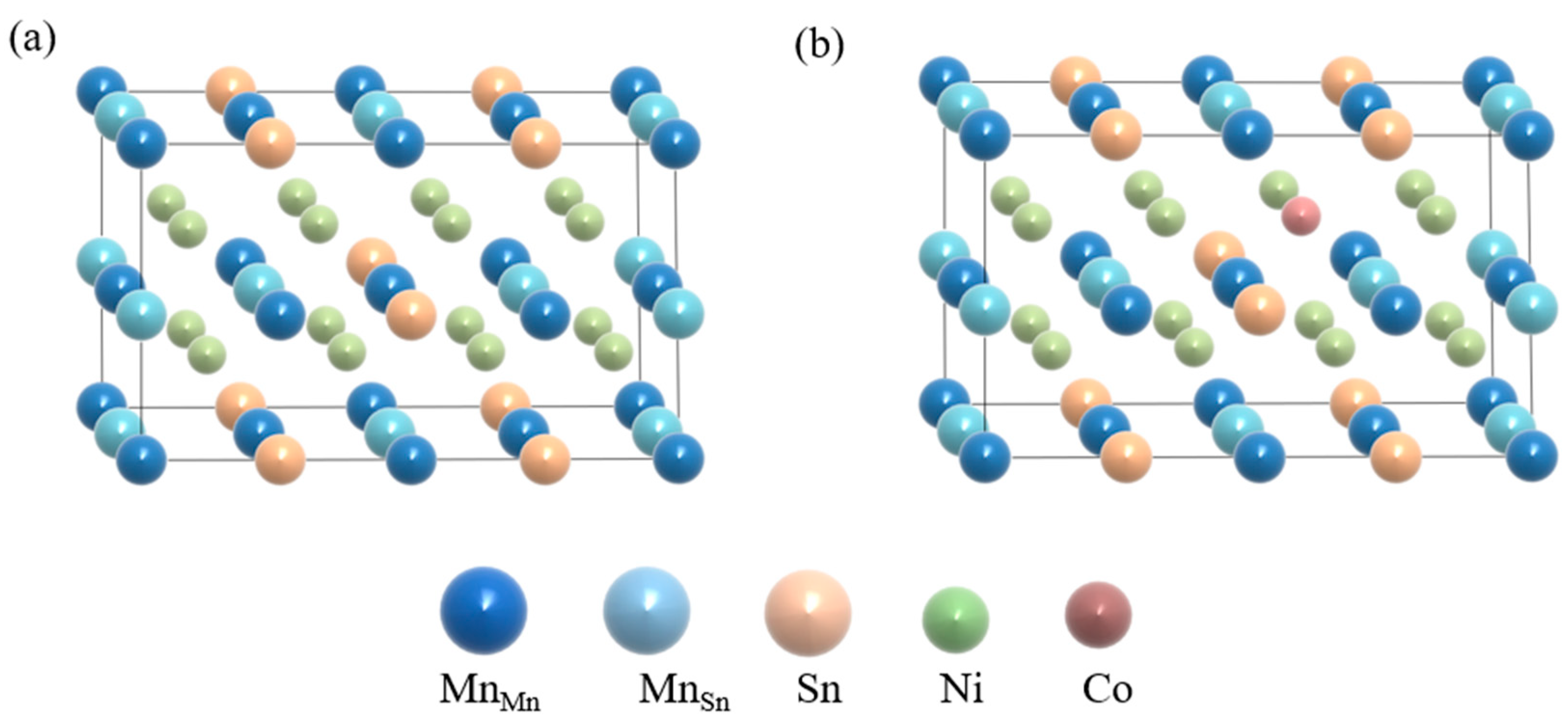

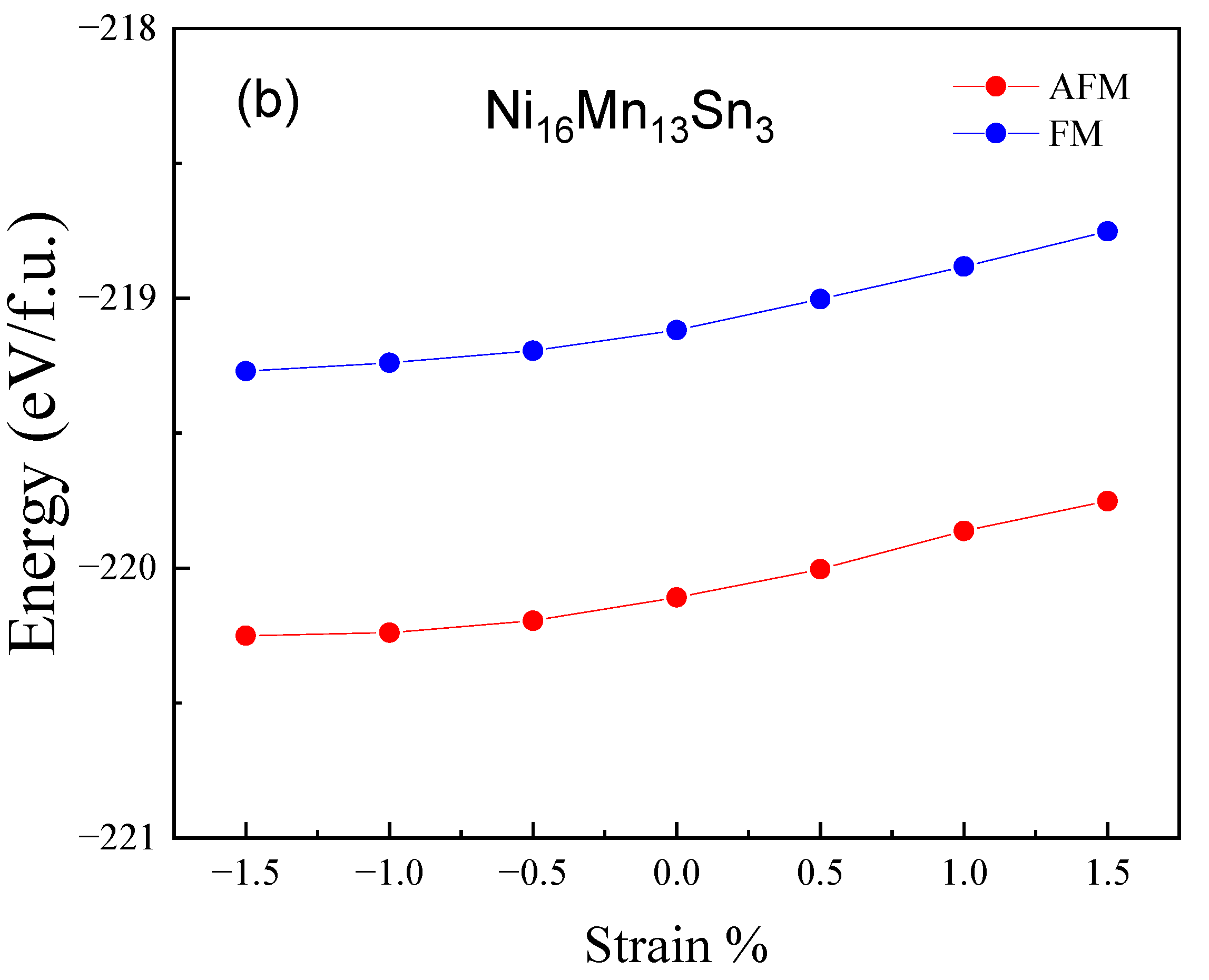

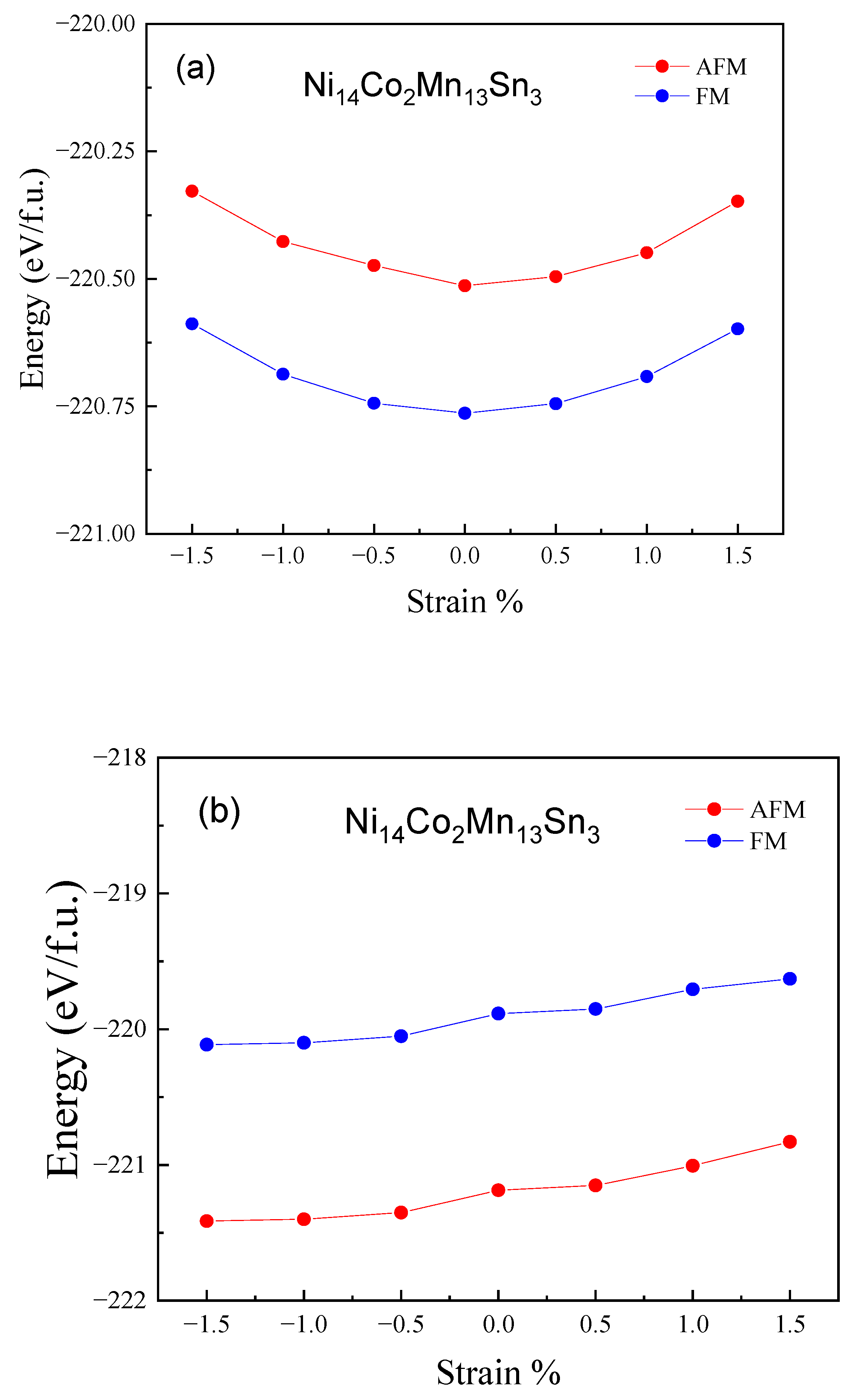

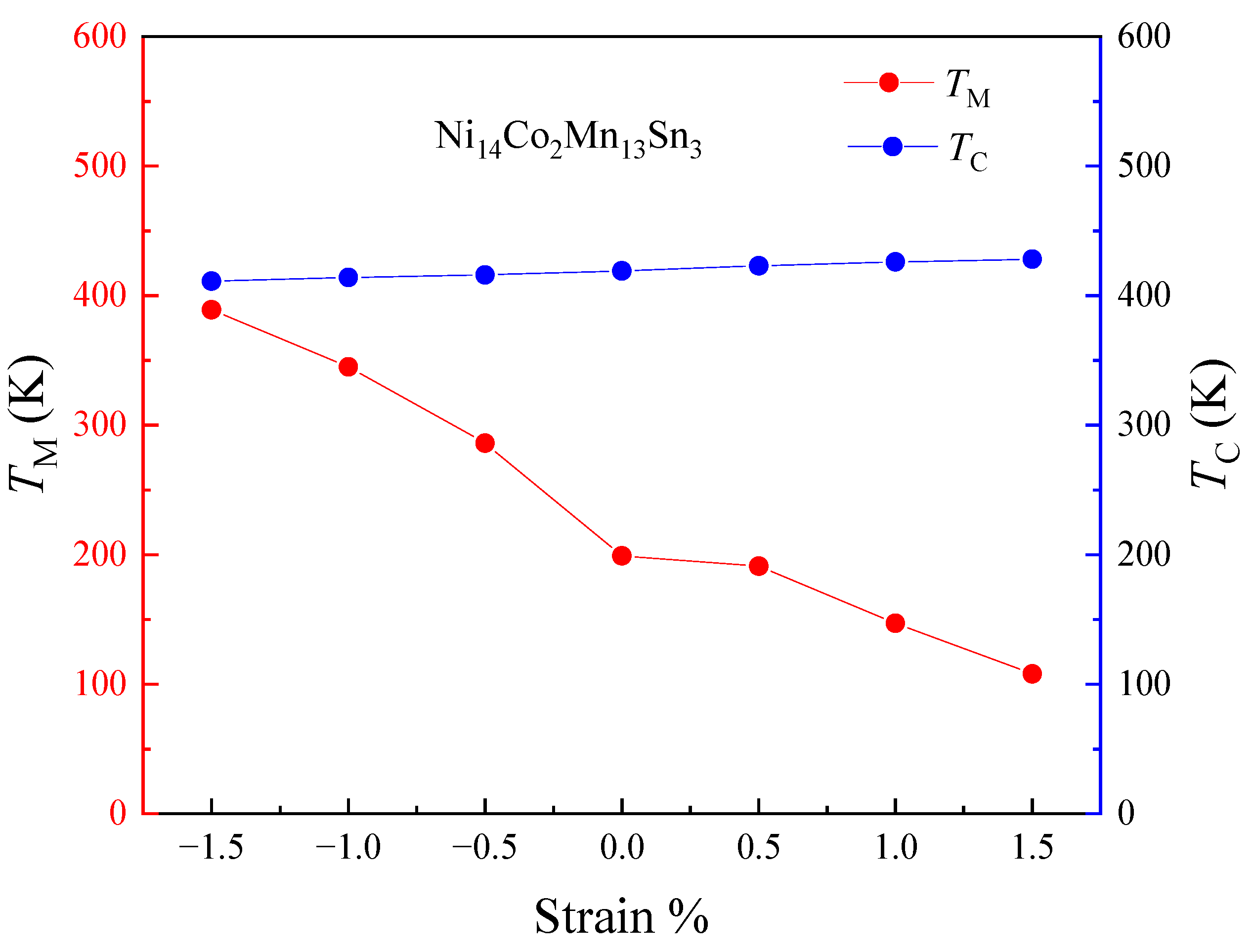
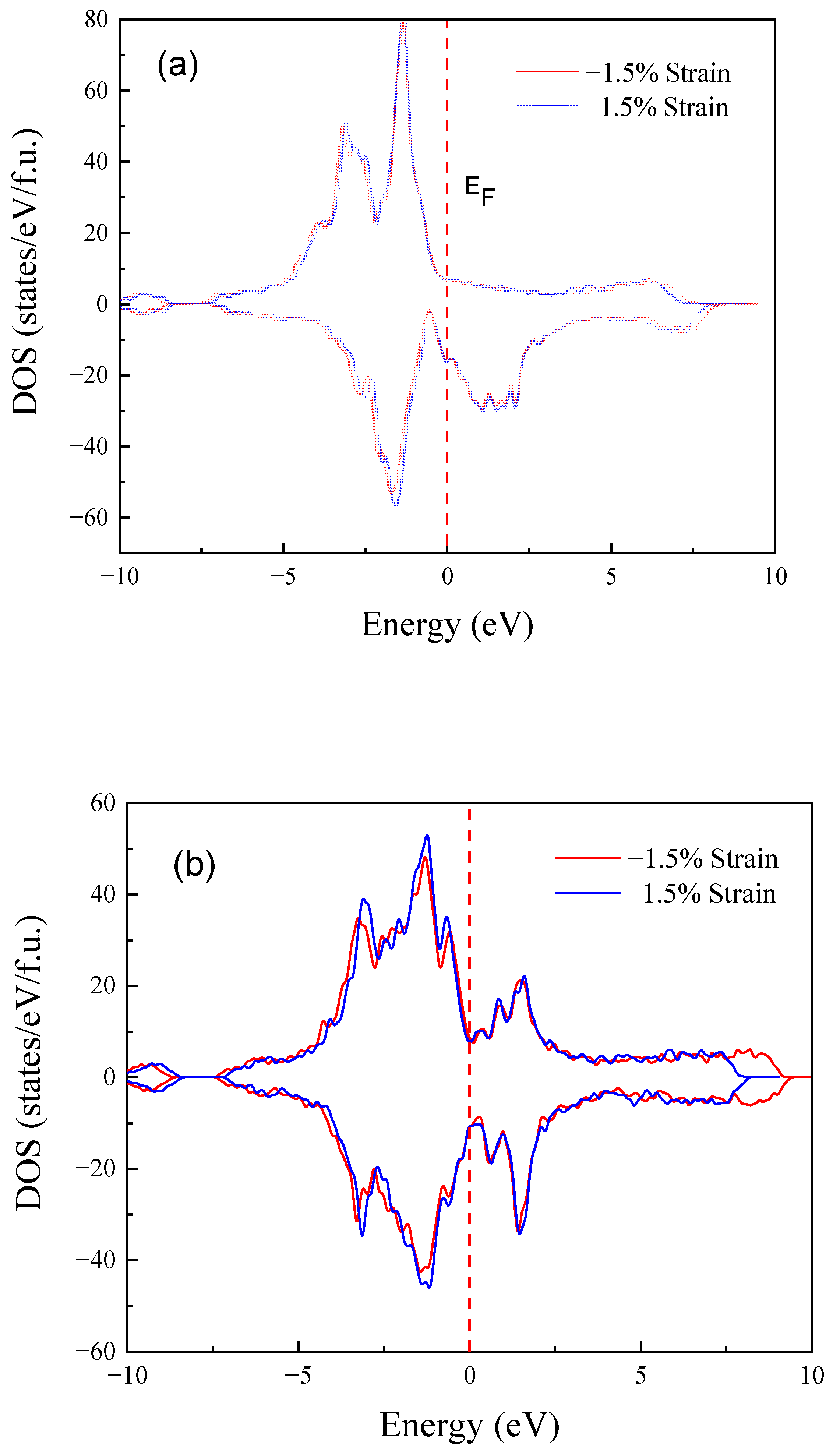


| Alloys | Strain % | Phase | a Å | c Å | Mt μB | |ΔM| μB | Magnetic State FM/AFM |
|---|---|---|---|---|---|---|---|
| Ni16Mn13Sn3 | −1.5 | Cub. | 5.85 | 5.94 | 1.36 | 0.06 | AFM |
| Tet. | 5.30 | 7.26 | 1.42 | AFM | |||
| −1.0 | Cub. | 5.88 | 5.94 | 1.37 | 0.05 | AFM | |
| Tet. | 5.33 | 7.26 | 1.42 | AFM | |||
| −0.5 | Cub. | 5.91 | 5.94 | 1.38 | 0.04 | AFM | |
| Tet. | 5.35 | 7.26 | 1.42 | AFM | |||
| 0 | Cub. | 5.94 | 5.94 | 1.39 | 0.04 | AFM | |
| Tet. | 5.38 | 7.26 | 1.43 | AFM | |||
| 0.5 | Cub. | 5.97 | 5.94 | 1.40 | 0.03 | AFM | |
| Tet. | 5.41 | 7.26 | 1.43 | AFM | |||
| 1.0 | Cub. | 6.00 | 5.94 | 1.41 | 0.02 | AFM | |
| Tet. | 5.43 | 7.26 | 1.43 | AFM | |||
| 1.5 | Cub. | 6.03 | 5.94 | 1.42 | 0.01 | AFM | |
| Tet. | 5.46 | 7.26 | 1.43 | AFM | |||
| Ni15CoMn13Sn3 | −1.5 | Cub. | 5.83 | 5.92 | 1.42 | 0.02 | AFM |
| Tet. | 5.35 | 7.06 | 1.44 | AFM | |||
| −1.0 | Cub. | 5.86 | 5.92 | 1.44 | 0.01 | AFM | |
| Tet. | 5.37 | 7.06 | 1.45 | AFM | |||
| −0.5 | Cub. | 5.89 | 5.92 | 1.44 | 0.01 | AFM | |
| Tet. | 5.40 | 7.06 | 1.45 | AFM | |||
| 0 | Cub. | 5.92 | 5.92 | 1.46 | 0 | AFM | |
| Tet. | 5.43 | 7.06 | 1.46 | AFM | |||
| 0.5 | Cub. | 5.95 | 5.92 | 1.47 | 0 | AFM | |
| Tet. | 5.46 | 7.06 | 1.47 | AFM | |||
| 1.0 | Cub. | 5.98 | 5.92 | 1.49 | 0.01 | AFM | |
| Tet. | 5.48 | 7.06 | 1.48 | AFM | |||
| 1.5 | Cub. | 6.01 | 5.92 | 1.50 | 0.01 | AFM | |
| Tet. | 5.51 | 7.06 | 1.49 | AFM | |||
| Ni14Co2Mn13Sn3 | −1.5 | Cub. | 5.84 | 5.93 | 6.98 | 5.48 | FM |
| Tet. | 5.32 | 7.15 | 1.50 | AFM | |||
| −1.0 | Cub. | 5.87 | 5.93 | 7.00 | 5.50 | FM | |
| Tet. | 5.35 | 7.15 | 1.50 | AFM | |||
| −0.5 | Cub. | 5.90 | 5.93 | 7.03 | 5.51 | FM | |
| Tet. | 5.37 | 7.15 | 1.52 | AFM | |||
| 0 | Cub. | 5.93 | 5.93 | 7.06 | 5.54 | FM | |
| Tet. | 5.40 | 7.15 | 1.52 | AFM | |||
| 0.5 | Cub. | 5.96 | 5.93 | 7.08 | 5.56 | FM | |
| Tet. | 5.43 | 7.15 | 1.52 | AFM | |||
| 1.0 | Cub. | 5.99 | 5.93 | 7.10 | 5.58 | FM | |
| Tet. | 5.45 | 7.15 | 1.52 | AFM | |||
| 1.5 | Cub. | 6.02 | 5.93 | 7.13 | 5.58 | FM | |
| Tet. | 5.48 | 7.15 | 1.55 | AFM |
| Alloys | Strain % | ΔEA-M (meV/atom) | ΔEP-F (meV/atom) | TM (K) | TC (K) |
|---|---|---|---|---|---|
| Ni16Mn13Sn3 | −1.5 | 31.7 | 385.7 | 405 | 397 |
| −1.0 | 29.6 | 387.8 | 378 | 399 | |
| −0.5 | 27.6 | 390.0 | 353 | 401 | |
| 0 | 24.6 | 393.3 | 314 | 405 | |
| 0.5 | 22.3 | 395.2 | 285 | 407 | |
| 1.0 | 19.4 | 397.6 | 248 | 409 | |
| 1.5 | 18.5 | 400.7 | 236 | 412 | |
| Ni15CoMn13Sn3 | −1.5 | 30.8 | 392.6 | 394 | 404 |
| −1.0 | 28.1 | 395.9 | 359 | 407 | |
| −0.5 | 26.8 | 397.7 | 343 | 409 | |
| 0 | 23.4 | 398.2 | 299 | 410 | |
| 0.5 | 21.6 | 403.4 | 276 | 415 | |
| 1.0 | 18.7 | 407.3 | 239 | 419 | |
| 1.5 | 17.8 | 410.4 | 227 | 422 | |
| Ni14Co2Mn13Sn3 | −1.5 | 25.8 | 399.6 | 330 | 411 |
| −1.0 | 22.9 | 402.1 | 293 | 414 | |
| −0.5 | 19.0 | 404.8 | 243 | 416 | |
| 0 | 13.2 | 406.9 | 168 | 419 | |
| 0.5 | 12.7 | 410.7 | 162 | 423 | |
| 1.0 | 9.8 | 413.8 | 125 | 426 | |
| 1.5 | 7.2 | 415.7 | 92 | 428 |
Publisher’s Note: MDPI stays neutral with regard to jurisdictional claims in published maps and institutional affiliations. |
© 2022 by the authors. Licensee MDPI, Basel, Switzerland. This article is an open access article distributed under the terms and conditions of the Creative Commons Attribution (CC BY) license (https://creativecommons.org/licenses/by/4.0/).
Share and Cite
Xia, Q.; Tan, C.; Han, B.; Tian, X.; Zhao, L.; Zhao, W.; Ma, T.; Wang, C.; Zhang, K. Strain Engineering in Ni-Co-Mn-Sn Magnetic Shape Memory Alloys: Influence on the Magnetic Properties and Martensitic Transformation. Materials 2022, 15, 5889. https://doi.org/10.3390/ma15175889
Xia Q, Tan C, Han B, Tian X, Zhao L, Zhao W, Ma T, Wang C, Zhang K. Strain Engineering in Ni-Co-Mn-Sn Magnetic Shape Memory Alloys: Influence on the Magnetic Properties and Martensitic Transformation. Materials. 2022; 15(17):5889. https://doi.org/10.3390/ma15175889
Chicago/Turabian StyleXia, Qinhan, Changlong Tan, Binglun Han, Xiaohua Tian, Lei Zhao, Wenbin Zhao, Tianyou Ma, Cheng Wang, and Kun Zhang. 2022. "Strain Engineering in Ni-Co-Mn-Sn Magnetic Shape Memory Alloys: Influence on the Magnetic Properties and Martensitic Transformation" Materials 15, no. 17: 5889. https://doi.org/10.3390/ma15175889






